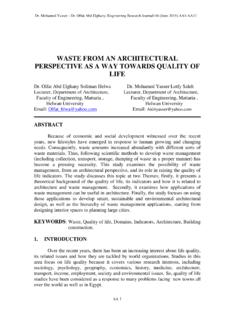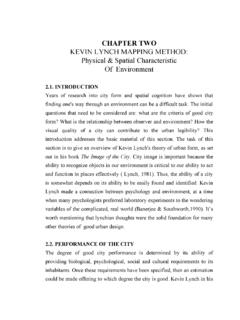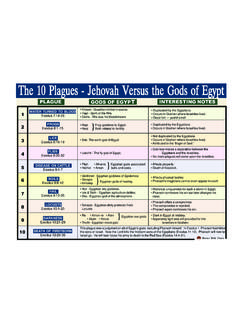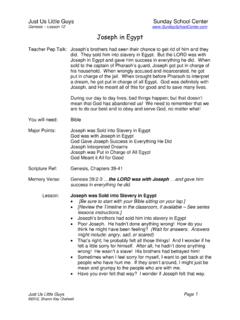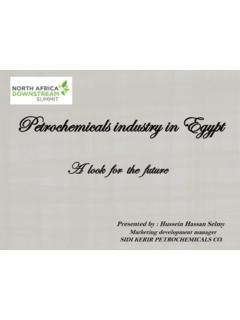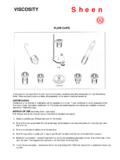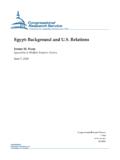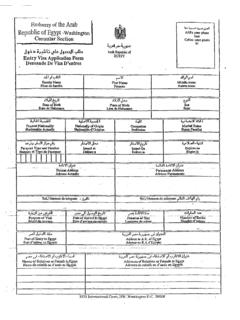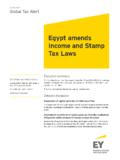Transcription of KEVIN LYNCH MAPPING METHOD : CHAPTER TWO
1 CHAPTER TWO KEVIN LYNCH MAPPING METHOD : Physical & Spatial Characteristic Of Environment INTRODUCTION Years of research into city form and spatial cognition have shown that finding one's way through an environment can be a difficult task. The initial questions that need to be considered are: what are the criteria of good city form? What is the relationship between observer and environment? How the visual quality of a city can contribute to the urban legibility? This introduction addresses the basic material of this section. The task of this section is to give an overview of KEVIN LYNCH 's theory of urban form, as set out in his book The Image of the City. City image is important because the ability to recognize objects in our environment is critical to our ability to act and function in places effectively ( LYNCH , 1981).
2 Thus, the ability of a city is somewhat depends on its ability to be easily found and identified. KEVIN LYNCH made a connection between psychology and environment, at a time when many psychologists preferred laboratory experiments to the wondering variables of the complicated, real world (Banerjee & Southworth,1990). It s worth mentioning that lynchian thoughts were the solid foundation for many other theories of good urban design. PERFORMANCE OF THE CITY The degree of good city performance is determined by its ability of providing biological, psychological, social and cultural requirements to its inhabitants. Once these requirements have been specified, then an estimation could be made offering to which degree the city is good.
3 KEVIN LYNCH in his book good city form summarized these requirements in five points, they are called performance dimension: The degree to which the city sustains the essential, biological performance of human beings: this is the supports of our bodies needs such as water, air, energy and food, there should be sufficient supply of them to sustain life, moreover good settlement should be free of danger, poisons and disasters, then it supports safety for its inhabitants. Sense It is the degree of fit between the physical city (form) and the way people recognize and organize it in their minds. In other words, it is the degree of homogeneity between environment and observer. Sense then, reflects the clarity with which people perceive the space.
4 Sense depends upon spatial structure, quality, the culture and the current purpose of the observer ( LYNCH , 1981). This dimension will be tackled in more detail later. Fit It is the match between the action (function) and the physical city (form), this is the requirements of our culture. It is how well the spatial and temporal pattern of a settlement matches the customary behavior of its inhabitants ( LYNCH , 1981 : 151). When there is congruence between form and patterns of behaviors, people feel comfortable; conversely, absence or lack of fit could make it uncomfortable and difficult to behave through an area. Accessibility That is not means the ability to reach transportation only, but to access to all things such as services, information, other places and to other peoples also, then an interaction is established between these variables.
5 Access offers the degree of choice and diversity presented to us. A place should provide people with information about physical ways of reaching it. Control It the degree to which the environment is under the control of the people who actually use it or reside in it. According to Hall, control gives people feelings of power and stability. People feel in control when there is enough social and physical space to do as they need. ANALYZING THE SENSITIVITY OF THE CITY It is clearly believed that building the image of an environment is a two way process, it is the result of an interaction between the observer and the environment in which he lives. The process is not just how we see things and others, but also how others see us as a part of environment.
6 Consequently, it reflects the influence of observer and environment on each other. nothing is experienced by itself, but in relation to its surroundings, the sequences of events leading up to it ( LYNCH ,1960: 1). Sense of the city as mentioned above represents the relationship between physical environment and cognition, since its components are the observer and his environment, this sense can be broken into six elements : Identity Identity is the characteristic that allow us to differentiate one space from another (Arthur & Passini, 1992: 87). It is the character and spatial attributes of an object or a place that enhance the ability of recognizing and identifying an environment, those attributes of the object make it distinct, ultimately unique and easily separable, then it stands for individuality or oneness (Lawson, 2 001).
7 Place identity is closely linked to personal identity, I am here supports I am ( LYNCH , 1981 : 132). There is not only an identity of place, but also an identity of events which differs naturally from the first as it gives peoples a means to remember events that happened, thus helps them to structure their life. Structure It is how the object is placed in the space considering its relation to the observer and to other objects, as the object is not seen isolated from surroundings but as a part of all environmental components. The architect has to realise that the forms of his buildings react on adjacent forms (Moughtin, 2003: 28). Aldo Rossi considered the city as a man-made object, a work of architecture and engineering that grows through time.
8 He said this is one of the most substantial hypothesis from which to work ( Rossi, et al.,1982 : 34). Norberg-Schulz and LYNCH refer to organization when they talk about structure. Meaning Meaning is that which the place stands for or represent (Lawson, 2001). It is a hidden character of the object and the deepen sense that reflects the importance of the object, this sense may be practical or emotional. For instance, the meaning of the door may be as a hole for getting out. The meaning is a complicated notion, its sides are difficult to be specified, but can be separated from the form in the early stages of analysis. A particular city may stands for enjoyment, power, vitality, mystery or something else presented in mental image of its inhabitants.
9 LYNCH says that the visual environment should be meaningful; that is, its visible character should relate to other aspects of life . Steinitz (1968) made an inference that the city becomes more meaningful and known to its inhabitants when there is a congruence between its physical form and activity ( Broadbent et al. , 1980). People select and filter information that is meaningful to them and build their choices on it. Congruence It is the relationship of the form to its function. In other words, how is the environmental structure congruent with nonspatial structure. For instance, what degree of congruence between a residential building and family size?. Congruence can be tested by comparing abstraction of place with abstraction of function.
10 Transparency (Immediacy) It stands for the degree of visibility of process occurring in the place to users. In other words, it is the degree to which one can actually see what's going. There are many events occur in the city such as selling, buying and movement, how many of them we can see actually. Definitely, we see less of what actually happening. Legibility It is the term that has been used for along time in urban planning defined as the ease with which its parts can be recognized and organized into a coherent pattern ( LYNCH , 1960:2). This definition estates that degree of legibility depends upon the formation of cognitive maps within wayfarers mind (Arthur & Passini, 1992). Legibility is the degree of distinctiveness that enables the viewer to understand or categorize the contents of a scene- the greater the legibility the greater the preference (Bell et al.)
